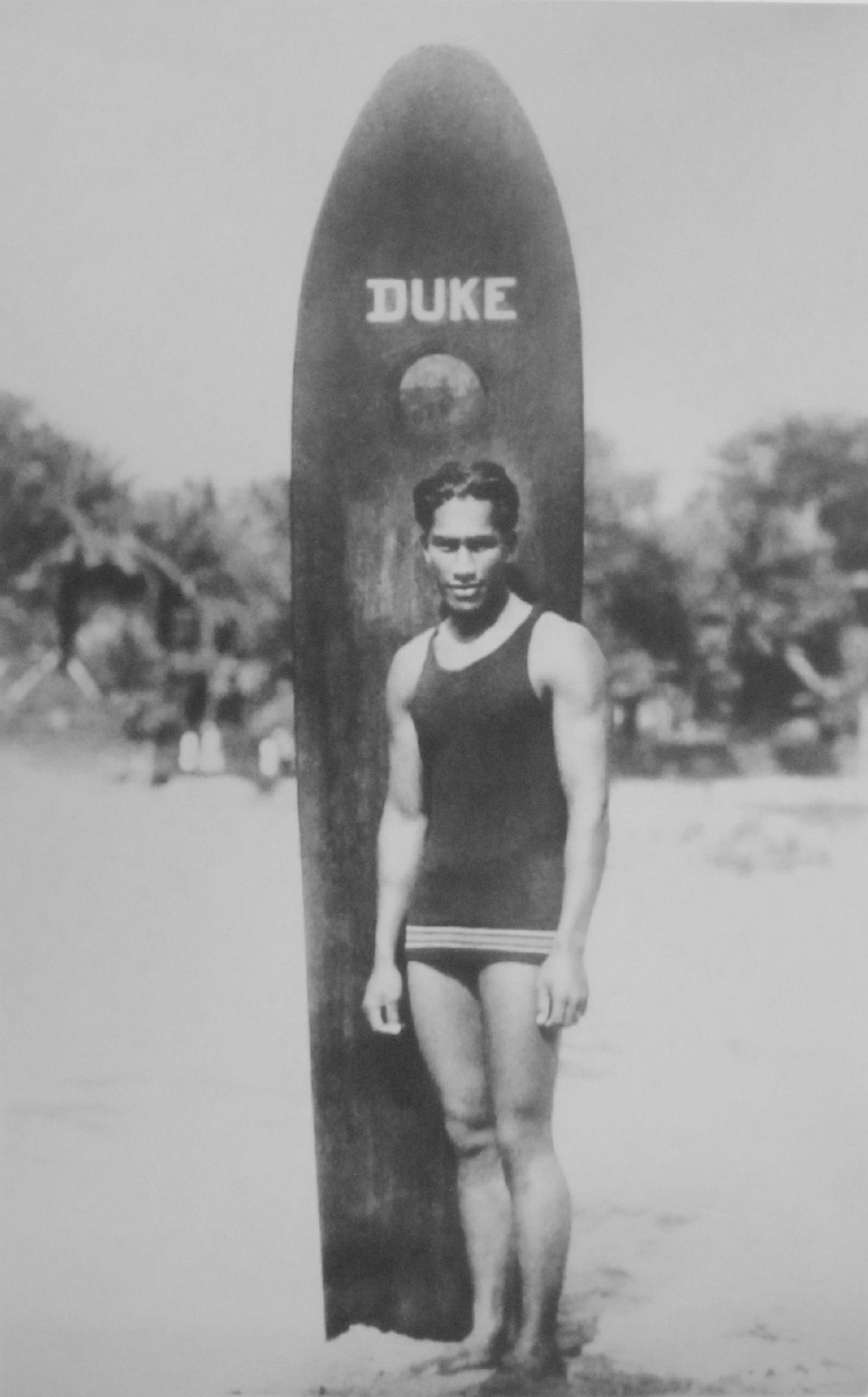January 2011 marked the inaugural Duke's Day celebration in Freshwater Beach, Australia. In 1914, Duke Kahanamoku accepted an invitation from Cecil Healy, a fellow Olympian, and friend, and travelled to Australia to compete in several swimming events. This trip turned into a three-month journey that would introduce Hawaiian surfing to locals and inspire the annual event called Duke’s Day.
Naomi Wilson and Naomi Donohue, aka the Surf Nomes, co-founded the first Duke’s Day on January 15th, 2011. The annual event includes a lei draping at Duke’s statue, water demonstrations, family activities, beach clean-ups, and more.
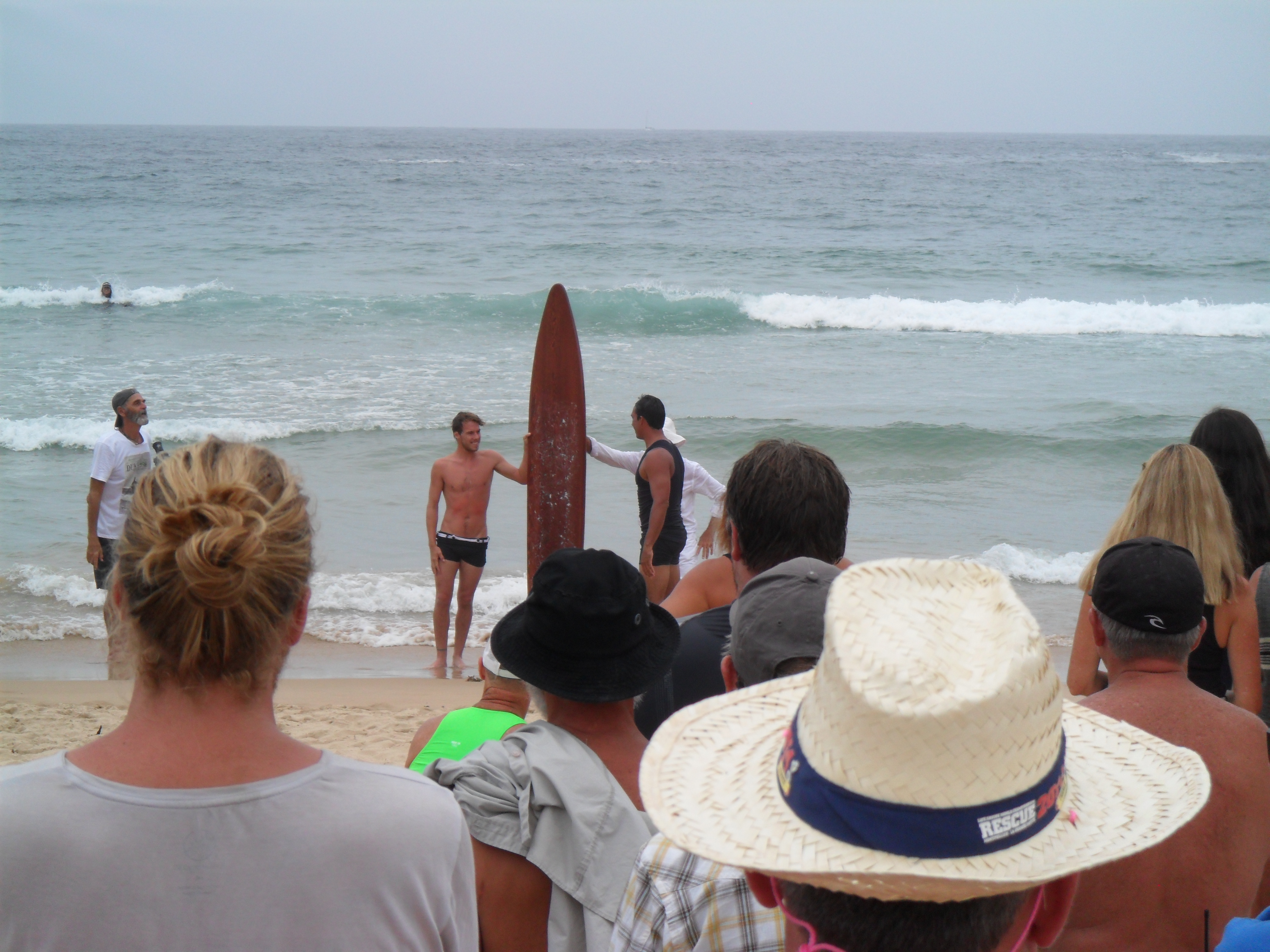
Duke's Day Re-enactment of Duke Kahanamoku visit and replica board, 2015. Photo L Johnson
Last week Freshwater SLSC became home to another tribute to Duke as our areas first Blue Plaque, one of 21 plaques across the state, was officially installed on Monday October 17th.
Arriving in Sydney in December 1914, news of his surfing skills soon appeared in local newspapers. On Christmas Eve, and then towards the end of the 1914-1915 Summer Season, he gave surfing displays at Freshwater and then Dee Why.
Reports from then tell us:
DUKE KAHANAMOUKU
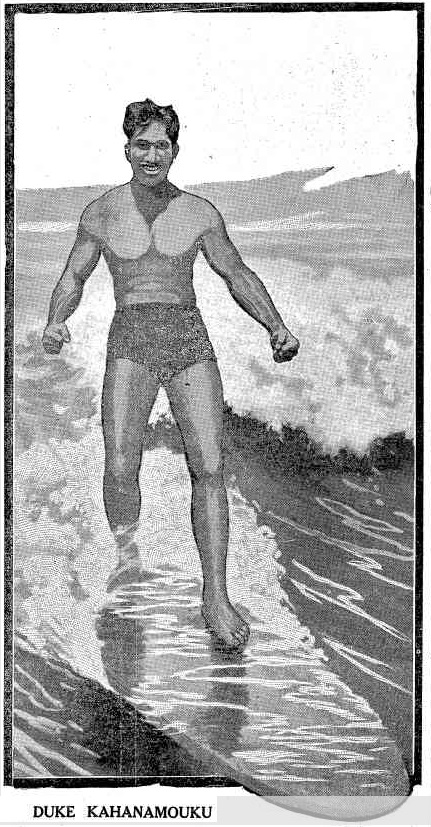
The marvellous Hawaiian, undisputed champion sprint distance swimmer of the world, some of whose natatorial feats are said to have astounded the fishes, as did the exploits of Pegoud, the French aviator, in the clouds, cause wonderment amongst the birds of the air. He is here seen performing one of his famous surfing accomplishments. This is not by any means his most daring achievement. Whilst dashing forward at an incredible speed, he stands on his head and does other things of an acrobatic description. Similar boards to the one he is shown using have been imported into Australia, but so far none of our surfing experts have been able to imitate his sensational deeds.
It is supposed, however, that the breakers that roll in on our shores are of a different formation, and not suitable for the purpose. All doubts on that subject would have been set at rest had Kahanamouku visited here this Summer, as was supposed to have been his intention. He has on several occasions expressed his willingness to come, but the time he originally offered to make the trip was regarded as inopportune by the officials of the Swimming Association who were carrying on the negotiations, and they fell through, owing to the date they suggested as a substitute clashing with the great water festival that is to be held at Honolulu on February 18 and 24 next. Visitors from all parts of the world have been known to go to Hawaii merely to witness Kahanamouku shoot the waves in the extraordinary fashion depicted above. DUKE KAHANAMOUKU (1913, December 14). Sunday Times (Sydney, NSW : 1895 - 1930), p. 20 (SUNDAY TIMES GLOBE PICTORIAL). Retrieved from http://nla.gov.au/nla.news-article126315151
SWIMMING: Kahanamouku and 100 yards championship. KAHANAMOUKU AND SURF BOARD. by Cecil Healy.
Representatives of the Press were invited to witness a private exhibition of surf-board riding by Kahanamouku at Freshwater on Thursday. It was to have been held the previous day, but the intention accidentally became public property and as several thousand people were attracted to the vicinity, Association officials decided to postpone it. Business considerations, unfortunately, prevented the writer from being present. Freshwater enjoys the reputation of being, on the whole, the best beach for shootable breakers, but the conditions, I understand, were far from being ideal for the purpose on that particular day.
The waves, for instance, were breaking too close to the shore to permit of a good 'run' being obtained, and, moreover, were of the 'dumping' variety; also the board itself, which was made locally, was not exactly what was required. It weighed in the neighbourhood of 100lb, whereas those in use at Honolulu, are only a quarter that weight. However, despite the disadvantages mentioned the Duke succeeded in assuming the perpendicular, and negotiating several shoots in his familiar poster attitude. On one occasion, whilst laying flat on the board, with a deft movement he swung the board right about, and proceeded backwards for a while before repeating the action and facing shorewards again. A number of our leading surfers were spectators of the display, and from what I can gather the general impression amongst them was that he did wonderfully well under the circumstances, but they were sure it merely amounted to an indication of what he is capable of doing under more favourable conditions. They have no doubt that when he has had opportunities of adapting himself to the vagaries of our surf, and strikes a suitable day, he will be able to do things of a really sensational nature. The dextrous manner in which he handled the heavy board when taking it out through the breakers would appear to have greatly surprised the Sydney men.
Record entries have been received for the year's State championships. Two are to be decided at the initial carnival, which is to be held at the Domain Baths next Saturday afternoon lamely, the 100yds and 880yds. The Olympic champion, Duke Kahanamouku, and his brilliant travelling companion, George Cunha, are competing in the former event. It will be their first public appearance in competition. Incidentally, it will constitute the first occasion that an overseas champion has raced in Australia. The visitors will be opposed by the cream of the Commonwealth's sprint-distance swimmers. Australian record-holder Albert Barry will defend his title of 100yds champion of New South Wales W. Longworth, runner-up in both State and Australian 'hundred' championships last season, will also be one of those who will endeavor to achieve for this State the honour of checking the Hawaiian's triumphant march. SWIMMING : Kahanamouku in 100yds Championship : (1914, December 30). Referee (Sydney, NSW : 1886 - 1939), p. 16. Retrieved from http://nla.gov.au/nla.news-article120278130
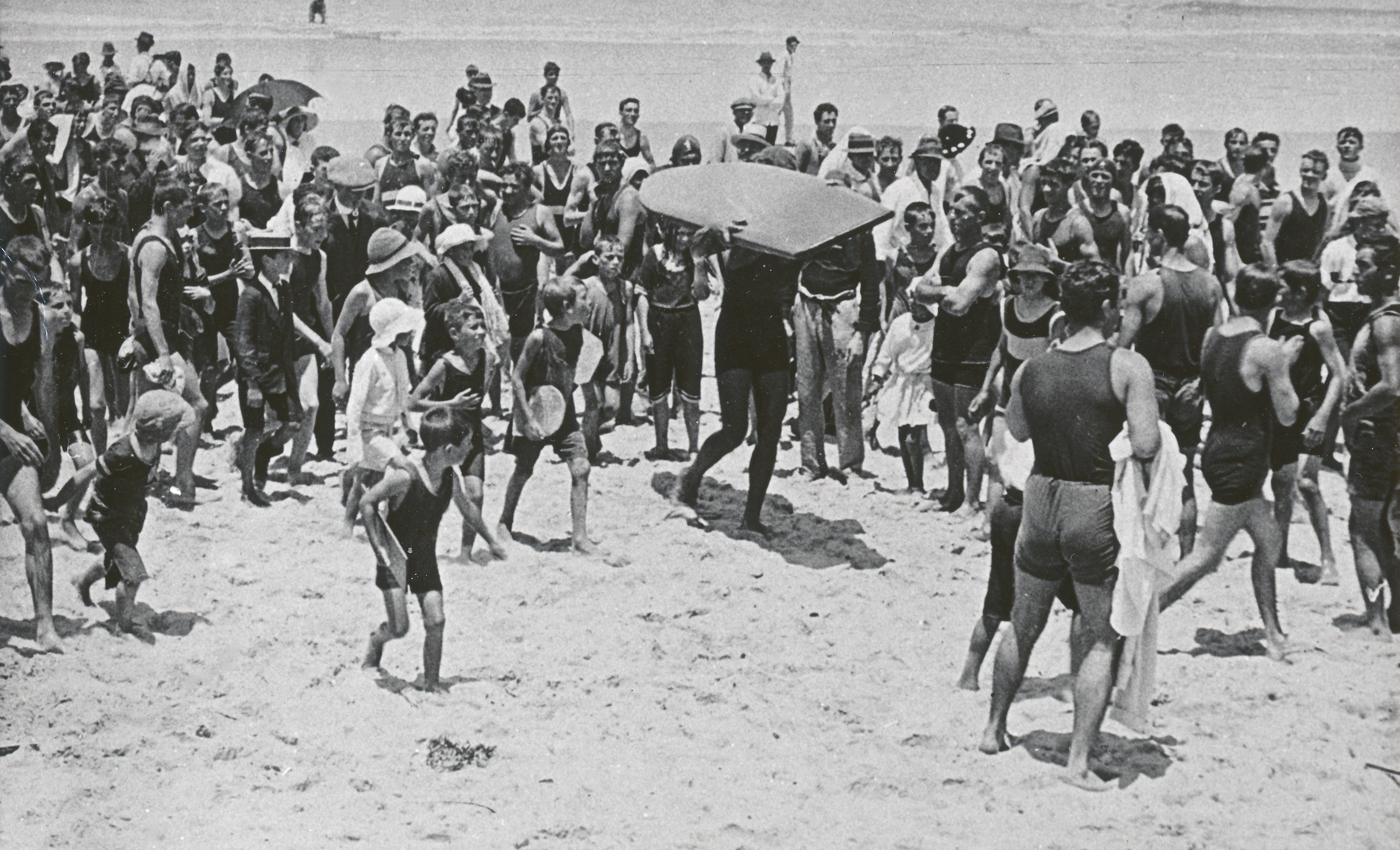
Duke Kahanamoku carrying his board up the beach at Freshwater. Photo by Frank Bell (1884-1923)
DEE WHY CARNIVAL. KAHANAMOKU AND HIS SURF BOARD.
D. P. Kahanamoku, the famous Hawaiian swimmer, gave an exhibition on the surf board at the Dee Why surf carnival on Saturday. The beach was lined with people, all anxious to obtain a good view. The various events were watched with interest, especially the performance of Kahanamoku. He came out with his surf board, plunged into the water and continued to swim out until those watching from the beach wondered when he would stop. After covering nearly half a mile, Kahanamoku turned and prepared for a roller, which came along a moment after ; he caught it, and as the wave carried him shorewards he performed all kinds of acrobatic feats on the board, and finally dived into the water as the roller broke. The crowd showed their appreciation in a very hearty manner. Kahanamoku remained in the surf for nearly an hour, and he was accompanied at intervals by Miss Letham, of Freshwater, and it was a rare sight to watch both swimmers on the surf board.
The various surf events under the control of the New South Wales Surf Bathing Association were well contested. An open-air concert at night concluded the day's sport. Details :—
Grand Parade of Clubs.—Dee Why, 1 ; North Steyne, 2.
Three-legged Race.—North Steyne, 1 ; Collaroy, 2.
Pennant Rescue and Resuscitation Competition.— Metropolitan Division, third round ; Bondi A, 57.77points, 1 ; Manly A, 57.47 points, 2 ; Coogee, 56.66points, 3 ; North Steyne, 52.03 points, 4.
Novice Surf Race.—A. V. Rein (Manly), 1 ; C. D. Bell (Manly), 2.
Tug-of-War.—Collaroy, A. L. Melrose, capt. ; C. Knight, J. Walton, A. Thew, J. Jack, J. Bloomfield, D. Scully), 1.
Beach Relay Race.—First heat : Collaroy, 1. Second heat : North Steyne, 1. Third heat : Coogee, 1. Final :Collaroy (L. Chinchen, T. V. Smith, A. Sheldon, L. Sheldon), 1 ; North Steyne (E. Goulding, G. Morgan,O. H. G. Merrett, C .Whitehead), 2.
Alarm Reel Race.—Manly (H. M. May, belt, O. Mater, H. Buhl, F. Bennett, D. West), 1 ; NorthSteyne (L. Hind, belt, F. Nicholls, B. McEwan, E. Goulding, N. Thompson), 2.
Cock Fight.—Balmoral ( J. Doudney, C. Walker), 1.Surf Brace Relay Race.—Manly (J. Brown and N. Smith), 1 ; North Steyne (C. Healy, L Solomon), andBondi (J. G. Brown and H. Fletcher), dead heat.
Novice Alarm Reel Race.—First heat : North Steyne,1 ; North Bondi, 2. Second heat : Coogee, 1. Thirdheat : Bondi, 1. Final : Coogee (J. Leary, H. Mason,H. McClure, R. Harret, M. Reubenstein), 1.
Wheelbarrow Race.—North Steyne (H. Nicholls, F. E. Nicholls), 1. DEE WHY CARNIVAL. (1915, February 8). The Sydney Morning Herald (NSW : 1842 - 1954), p. 13. Retrieved from http://nla.gov.au/nla.news-article15549791
The first 3 Blue Plaques for our harbour city were installed on October 11th, celebrating some of the Sydney's most extraordinary historic figures.
Minister for Heritage James Griffin, and MP for Manly, said the May Gibbs, Brett Whiteley and Sir Edward Hallstrom Plaques were installed in Neutral Bay, Lavender Bay and Mosman.
"Every Australian remembers tales of gumnut babies and 'big bad Banksia men' from childhood, and May Gibbs shaped generations of children's responses to nature," Mr Griffin said.
"The May Gibbs Blue Plaque, which has been installed at Nutcote in Neutral Bay, celebrates her grand legacy as Australia's first full-time, professionally trained children's book author and illustrator, whose work continues to delight readers to this day.
"The Sir Edward Hallstrom Blue Plaque, installed at the entrance of Taronga Zoo, recognises a self-made entrepreneur and philanthropist who cared deeply about conservation and remains one of the Zoo's most generous private benefactors.
"The NSW Government's $5 million Blue Plaques program is a fantastic way of getting communities excited about and involved in their local heritage around the State."
Member for North Shore Felicity Wilson said the Brett Whiteley Blue Plaque, now installed at his home in Lavender Bay, is a must-see for visitors to Wendy Whiteley's Secret Garden.
"Archibald-winning Brett Whiteley created some of his most famous works at his home and studio in Lavender Bay, inspired by views of Sydney Harbour," Ms Wilson said.
"These Blue Plaques celebrate and recognise the important contributions that Sir Edward Hallstrom, May Gibbs, and Brett Whiteley have made not only to our local community, but across NSW and Australia.
"We are incredibly fortunate to have such rich local heritage, and these Blue Plaques will ensure we are safeguarding our cultural heritage for future generations."
These are the third, fourth and fifth Blue Plaques ever to be installed in New South Wales. The first was the Caroline Chisholm Plaque in East Maitland. The second was the Nancy Bird Walton Plaque in Kew, Port Macquarie.
So far, 21 Blue Plaque recipients have been named, and the NSW public will be invited to nominate more noteworthy people, stories and events when a second round of nominations opens.
The Duke's Blue Plaque is the third tribute at Freshwater to the surfing great.
Duke Kahanamoku is also commemorated with a statue sculpted by Barry Donohoo, commissioned by Harbord Diggers and Warringah Council in 1994.
Duke Kahanamoku Park on the Northern Headland of Freshwater Beach became part of the Manly-Freshwater World Surfing Reserve on Saturday, March 10th 2012.
Duke Paoa Kahinu Mokoe Hulikohola Kahanamoku (1890 – January 22, 1968) was a Hawaiian competition swimmer who popularized the ancient Hawaiian sport of surfing. He was a five-time Olympic medalist in swimming.
Duke won a gold medal in the 100 metres freestyle in the 1912 Olympics in Stockholm, and a silver with the relay team. During the 1920 Olympics in Antwerp, he won gold medals both in the 100 meters, and in the relay. He finished the 100 meters with a silver medal during the 1924 Olympics in Paris. Between Olympic competitions, and after retiring from the Olympics, Kahanamoku traveled internationally, particularly Australia and the United States, to give swimming exhibitions. It was during this period that he popularized the sport of surfing, previously known only in Hawaii, by incorporating surfing exhibitions into these visits as well.
His surfing exhibition at Sydney`s Freshwater Beach on December 24th, 1914 is widely regarded as the most significant day in the development of surfing in Australia, although clearly people were trying to surf at Manly and Pittwater before he showed them how:
Messrs.T. Gunning and Bell, two prominent surfers at Manly, have been practising with a surf-board during the past week. The board, which was obtained from Honolulu, is fully 8ft. long and over 2ft. wide. By it said the Hawaiians make really wonderful displays in the surf. The sea breaking over, the coral ring, which encircles the island sends the surf in foaming rustics nearly a quarter of a mile to the beach. Poised in all position on these boards— even standing— the natives are borne in at express speed to the beach. The two Manly experimenters, though few would equal them in open shooting, are not adepts with the board, but hope later on to give some displays with it.
They state that with Its aid shooting after a wave has broken is easy, and the pace is far greater than in ordinary shooting. The pastime is therefore the most exhilarating. It is, of course, only possible to use the board at unfrequented places along the beach, and the danger of it killing or maiming anyone who was in its path will prevent it being used more than for spectacular displays. AMONGST THE BREAKERS. (
1910, April 14).
The Star (Sydney, NSW : 1909 - 1910), p. 2. Retrieved from
http://nla.gov.au/nla.news-article228314316
SURF BOARDS AT FRESHWATER.
THEIR USE CONSIDERED , DANGEROUS.
At the meeting of the Warringah Shire Council, a letter was read from the Freshwater Surf Club, which caused some discussion. The secretary of the club wrote, pointing out that the police officer stationed at Freshwater, acting under the authority of the council, had prohibited the use of surf boards; The committee of the club thought if the use of boards were stopped, it would deprive many of the members and visitors of the full enjoyment of the exhilarating surf.. The writer admitted that the practice of using boards by 'shooters' in the surf was doubtless attended with danger if used among ordinary surfers, but if restricted to one part or corner of the beach there would be practically no danger. The writer concluded by asking for authority to regulate the use of surf boards on Freshwater Beach. President Quirk and a number of the councillors said the use of boards by surf bathers was a danger to other bathers, and should be discontinued. It was unanimously agreed not to permit the use of the boards at Freshwater.
Constable Miller's energetic action in smashing up all the dangerous surf boards at Freshwater has been most effective, as not an offending piece of wood was to be seen in the breakers last Sunday. The new premises of tho Freshwater Surf Club are almost completed, and it is expected that tho club will bo In possession at tho end of the year. ' AMONG The BREAKERS (
1910, December 22).
The Sun (Sydney, NSW : 1910 - 1954), p. 9 (FINAL EXTRA). Retrieved from
http://nla.gov.au/nla.news-article229976700
THE SURF BOARD.
The use of surf boards is forbidden in Sydney, but where there are not so many people bathing you can do some fine shooting with it. The board—as light as you can get it—should be 2ft or slightly under in length, and not more than 18in. in width. Time the wave as already suggested. The board is gripped in in the centre at each end, the further edge inclining upward from the water at an angle of less than 45 degrees. It is held at arm's length. Try it only where there are not many people bathing together at one time. THE SURF BOARD. (1911, January 17). The Argus (Melbourne, Vic. : 1848 - 1957), p. 9. Retrieved from http://nla.gov.au/nla.news-article10871838
Not sure where The Argus found its information as:
The annual carnival of the Bondi Surf Bathers' Life-Saving Club has been fixed for February 25, when an excellent programme has been arranged. Besides the ordinary life-saving competitions there are many novel and Interesting items which have never been seen before at these aquatic carnivals. One feature will be the "shooting" the waves on the long Honolulan surf boards. AMONG The BREAKERS (1911, February 2). The Sun (Sydney, NSW : 1910 - 1954), p. 3 (LATEST EDITION). Retrieved from http://nla.gov.au/nla.news-article221582842
Despite the 'forbidden' one visitor may have given spark through a demonstration in Sydney during Autumn 1911:
MUSCULAR MUSICAL DIRECTOR
TALKS OF SURF-SHOOTING. HAWAIIAN WILL GIVE EXHIBITION.
A surf-shoot two miles long is one of the attractions Hawaii has to offer, according to Mr. Ernest Kaai, musical director of the band of Royal Hawaiians, who are now giving concert entertainments in Sydney. Mr. Kaai does not look like a musical director. He does not wear his hair long, nor Is ho plagued with a temperament which causes him to burst out Into violent fits of temper bordering upon hysteria. Rather, he looks like a successful heavyweight pug-Mist, or an international Rugby forward. Mr. Kaai weighs 2971b., is 46in. round the chest (normal measurement), and he has a 17!41n. calf. Mr. Kaal's speciality outside of- music Is surf-board shooting. Ho can, stand on his head on a board which comes In ahead of a wave at express-train speed. But he explains that that Is not the hardest thing to do in regard to surf-shooting. The limit, according to him, is standing on tho board with your back to tho beach. A parallel is found In a driver of a spring cart looking over tho tailboard. Instead of at tho horse, while the vehicle Is In motion. Only the trick on the board is harder. Mr. Kaai is going to give an exhibition on one of the Sydney beaches before he leaves Sydney, and It should prove of interest, for the reason that while local swimmers surf shoot in a fashion that arouses admiration wherever it is seen, they know nothing of board shooting. Mr. Kaal is of opinion that an expert swimmer can stand on a board Inside three months if it is practised daily.MUSCULAR MUSICAL DIRECTOR (1911, April 15). The Sun (Sydney, NSW : 1910 - 1954), p. 10 (FINAL SPORTING). Retrieved fromhttp://nla.gov.au/nla.news-article221568416
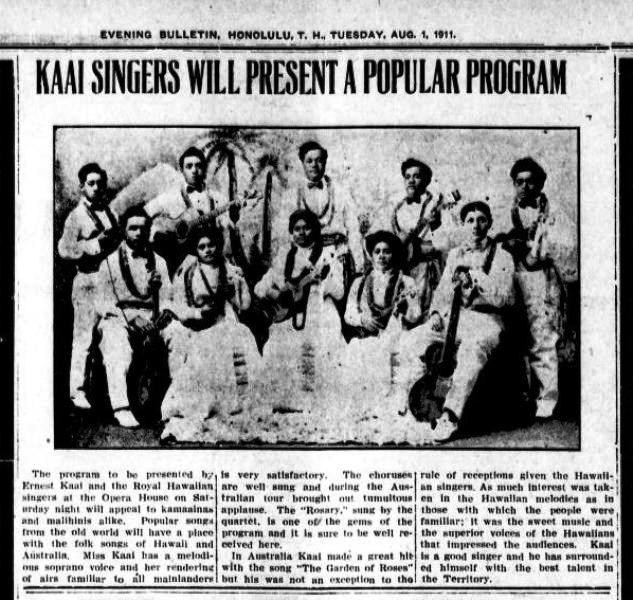
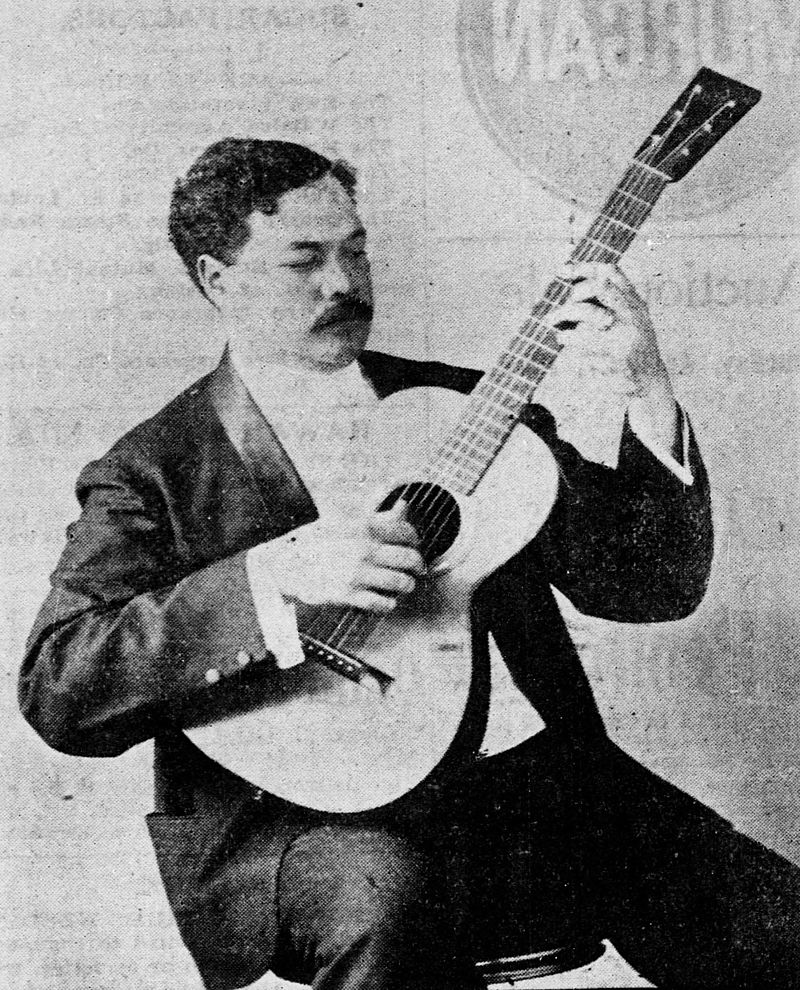
Ernest Kaleihoku Ka'ai in The Pacific Commercial Advertiser, 1907
Ernest Kaʻai (1881–1962) was considered by many to have been the foremost ukulele authority of his time, cited by some as being "Hawaii's Greatest Ukulele Player". Kaʻai, who was born in Honolulu, Hawaii, was said to have been the first musician to play a complete melody with chords.
SURF-RIDING AT HONOLULU
SURF-BATHING as a sport is, without doubt, one of our most popular diversions, and notwithstanding the fact that it is attended with an element of risk, as is evidenced by the recent calamity at Coogee, it is safe to say that it has come to stay. Many of our regular surf-bathers have become highly expert
in shooting the breakers, and their exploits in that fascinating pastime are at once the envy and the admiration of the novice. But, after all, we are only children at the game. Centuries ago the natives of Hawaii had attained a pitch of perfection at the art of surf-riding which would leave our best exponents far in the rear, and the bronze skinned Hawaiian. of to-day is just as expert as his ancestors.
There, how-ever, the surf-board is in vogue, and almost incredible feats are performed by the expert riders. It is quite a common thing for the surfer, standing on his board before the crest of a roller, to be carried over half a mile at Waikiki Beach, near Honolulu; while after a storm, the rider can start his trip over a mile out to sea and be landed right up on the beach. At Hilo Bay there are rollers after a big storm that carry native riders 5 miles at a run, and on the island of Nichau there are said to be even more wonderful feats performed. To stand on these frail boards and guide them with the feet is itself an accomplishment requiring skill, nerve, and constant practice; but the Hawaiian riders leap from one board to another at full speed, climb on each other's shoulders, and perform other remarkable feats. The natives have, however, a serious rival in the white man, who is becoming almost as expert on the surf-board.
A most interesting account of this sport, by one of the Honolulu experts, appears in a new, magazine entitled the Mid-Pacific. This periodical, which is splendidly got up, is published in Honolulu, one of its main objects being to promote tourist traffic across the Pacific, and to boom Honolulu, and other countries such as New Zealand and Australia, which would be included in the tourist's itinerary. This is with out doubt a matter of great importance to the countries concerned, and the Commonwealth Government has shown its appreciation of the scheme by delegating Mr. Percy Hunter, the Director of the New South Wales Immigration and Tourist Bureau, to represent it at a Pan-Pacific Congress, which is to be held at Honolulu this month. The Mid-Pacific, if it obtains the circulation its promoters anticipate, should do a great deal to arouse interest in travel on this side of the world.
There are two kinds of boards for surf-riding. One is called the olo, and the other the a-la-ia, known also as omo. The olo was made of wiliwili — a very light, buoyant wood— some 3 fathoms long, 2 or 3 feet wide, and from 6 to 8 inches thick along the middle of the board, lengthwise, but rounding toward the edges on both upper and lower sides. It is well known that the olo was only for the use of the chiefs; none of the common people used it. They used the a-la-ia, which was made of koa, or ulu. Its length and width was similar to the olo, except in thickness, it being but of 1½ to 2 inches. thick along its centre. The line of breakers is the place where the surf rises and breaks at deep sea. This is called the kulana nalu. Any place nearer or closer in, where the surf rises and breaks again, as it sometimes does, is called the ahua, known also as kipapa or puao.
There are only two kinds of surfing in which riding is indulged; these are called kakala, known also as lauloa or long surf, and the ohu, sometimes called opuu. The former is a surf that rises, covering the whole distance from one end of the beach to the other. This, at times, forms in successive waves that roll in with high, threatening crest, finally falling over bodily. The first of a series of surf waves usually partakes of this character, and is never taken by a rider, us will be mentioned later. The ohu is a very small comber that rises up without breaking, but of such strength that it sends the board on speedily. This is considered the best, being low and smooth, and the riding thereon easy and pleasant, and is there-fore preferred by ordinary surf-riders. The lower portion of the breaker is called honua, or foundation, and the portion near a cresting wave is termed the muku side, while the distant, or clear side, as some have expressed it, is known as the lala.
During calm weather, when there was no surf, there were two ways of making or coaxing it practised by the ancient Hawaiians, the generally adopted method being for it swimming party to take several strands of the sea convolvulus vine, and, swinging it around the head, lash it down unitedly upon the water until the desired result was obtained. The swimmer, taking position at the line of breakers, waits for the proper surf. As before mentioned, the first one is allowed to pass by. It is never ridden, because its front is rough. If the second comber is seen to be a good one it is sometimes taken, but usually the third or fourth is the best, both from the regularity of its breaking and the foam-calmed surface of the sea through the travel of its predecessors. In riding with the olo or thick board, the board is pointed landward, and the rider, mounting it, paddles with his hands and impels with his feet to give the board a forward movement, and when it receives the momentum of the surf, and begins to rush downward, the skilled rider will guide his course straight, or obliquely, apparently at will, according to the spending character of the surf ridden, to land himself high and dry on the beach, or dismount on nearingit, as he may elect. This style of riding was called kipapa. In using the olo great care had to be exercised in its management, lest from the height of the wave — if coming in direct — the board would be forced into the base of the breaker, instead of floating lightly and riding on the surface of the water, in which case, the wave-force being spent, the reaction throws both rider and board into the air. In the use of the olo the rider had to swim around the line of surf to obtain position, or be conveyed thither by canoe. To swim out through the surf with such a buoyant bulk was not possible, though it was sometimes done with the thin boards, the a-la-ia. These latter are good for riding all kinds of surf, and are much easier to handle than the olo.
Kaha nalu is the term used for surf-swimming without the use of the board, and was done with the body only. The swimmer, as with a board, would go out for the position, and, watching his! opportunity, would strike out with hands and feet, to obtain headway, as the approaching comber, with its break-ing crest, would catch him, and with his rapid swimming powers bear him onward with swift momentum, the body being submerged in the foam, the head and shoulders only being seen. Kala experts could ride on the lala, or top of the surf, as if riding with a board. SURF-RIDING AT HONOLULU (1911, March 17). The Richmond River Express and Casino Kyogle Advertiser (NSW : 1904 - 1929), p. 5. Retrieved from http://nla.gov.au/nla.news-article125698540
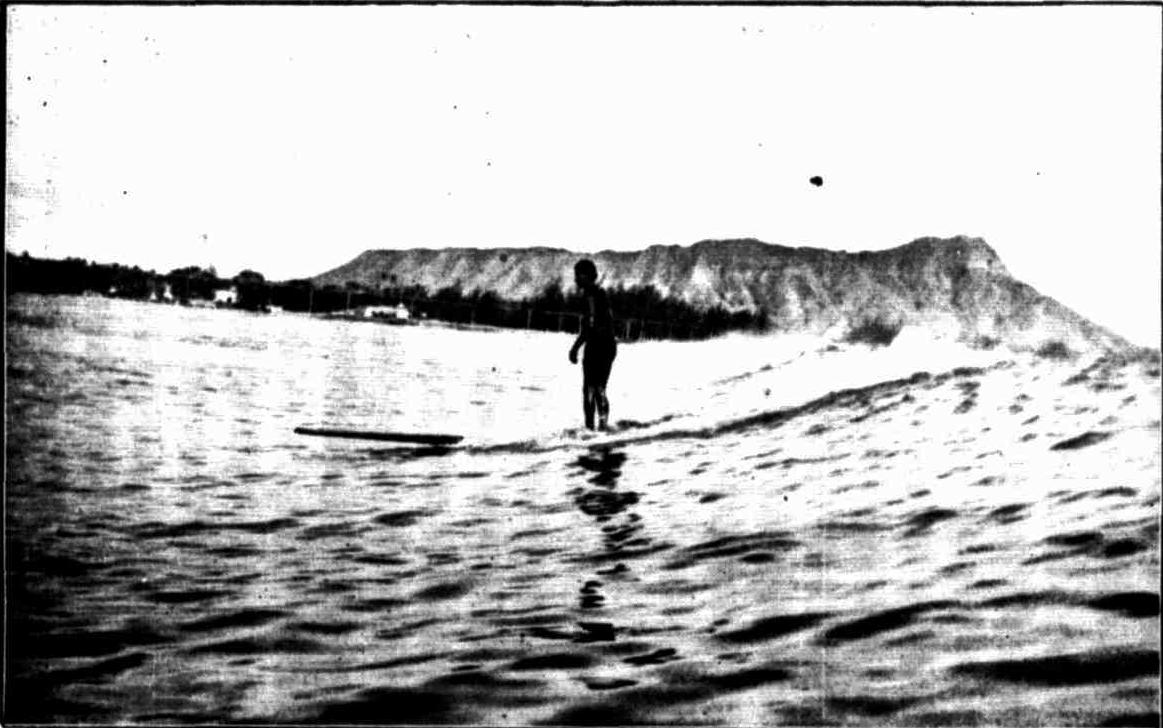
SURF BOARD RIDING WAIKIKI BEACH, HONOLULU.
If Alick did bring a surfboard here, he may have known this 1912 surf-board rider on Freshwater Beach - two whole years before the famous Duke exhibition:
The surf-board maniac was in evidence on the beach at Freshwater for about a quarter of an hour on Sunday, but the prompt action of the "man in blue" prevented any likelihood of danger to bathers near the shore. The careless "shooters' should also be looked after. AMONG The -- BREAKERS (1912, February 14). The Sun (Sydney, NSW : 1910 - 1954), p. 5. Retrieved from http://nla.gov.au/nla.news-article222007076
It is to be hoped that the lead given by the police at Freshwater In ridding the beach of the surf-board maniac will be followed at every other, bathing centre. As is usual in all such cases the pest is essentially a selfish individual. He shows no consideration for the pleasure and safety of others. As long as he is able to obtain a good "shoot" he cares not for anybody. These boards have been responsible for many cases of Injury in the surf, and it is to be hoped that they will be removed before a fatality occurs. It would be the simplest thing Imaginable for a board to rupture the kidneys or some other organ, and that is what will happen unless the authorities interfere. AMONG The BREAKERS (
1912, February 21).
The Sun(Sydney, NSW : 1910 - 1954), p. 9. Retrieved from
http://nla.gov.au/nla.news-article222002676
Though the practice of using surf-boards among the bathers on the beaches has been condemned In this paper time and again, it still continues, though not to such an extent as in previous years. Serious accidents have been caused In this mariner, and the police and councils should use their powers to the utmost extent in putting down the evil. AMONG The BREAKERS (1912, February 28). The Sun (Sydney, NSW : 1910 - 1954), p. 9. Retrieved from http://nla.gov.au/nla.news-article222008597
Is this gentleman the 'surf-board maniac'?;
Tommy Walker Says— 'I Brought First Surfboard To Australia'
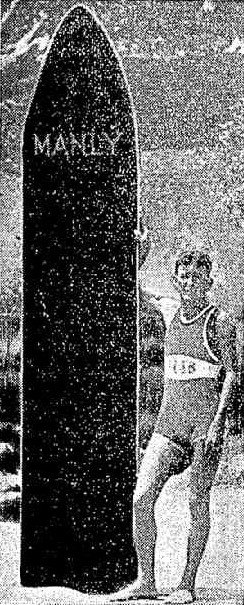 IN a letter to Harry M. Hay, Australia’s foremost swimming and, surf coach, Tommy Walker, one-time surfboard champion at Manly (N.S.W.), writes: 'I saw an article by you in 'The Referee' re surfboards, so enclose a photo of myself and surfboard taken in 1909 at Manly. This board I bought at Waikiki Beach, Hawaii, for two dollars, when I called there aboard the 'Poltolock.' I won my first surfboard shooting competition at Freshwater carnival back in 1911, and that wasn't yesterday. Regards.'
IN a letter to Harry M. Hay, Australia’s foremost swimming and, surf coach, Tommy Walker, one-time surfboard champion at Manly (N.S.W.), writes: 'I saw an article by you in 'The Referee' re surfboards, so enclose a photo of myself and surfboard taken in 1909 at Manly. This board I bought at Waikiki Beach, Hawaii, for two dollars, when I called there aboard the 'Poltolock.' I won my first surfboard shooting competition at Freshwater carnival back in 1911, and that wasn't yesterday. Regards.'
Walker was a well-known figure at Manly at the time he writes about. He figured in a couple of unusual, if not remarkable, incidents.
Time came when Tommy decided to catch a shark for the purpose of exhibiting it to the public at threepence a head. He brought three other lads into the enterprise and between them they raised the necessary capital to buy a hook and line and to hire a tent in which to install the monster of the deep. But first they 'had 'to catch their fish. They selected Fairy. Bower beach as their base and set a watch on the hill overlooking it. On the second day of their vigil, the required shark was sighted. Like a policeman on his beat, he came leisurely from the direction of South Steyne. And he was a Whopper, a tiger, 14ft 2in in length, as was proved later. He was duly landed struggling on the beach and a curious public had paid £12/10/to view him when the Council's inspector of nuisances intervened to the manifest relief of the residents in the vicinity. But one may ask, 'Where' does the hero stuff come in?' Well, it was this way. When the shark was sighted, the watchers on the. Hill signalled to Tommy (who was waiting on the' beach) and he immediately set out in a small dinghy to drop the bait at the spot it was anticipated the shark would cross. The craft capsized. So Tommy swam with the bait, a -7lb salmon, and literally spilt it into the shark's mouth. The shark grabbed it— and the rest was easy. Someone said, 'I ..wouldn't have done that for £10,000.' ..Tommy replied simply, .''There was no danger — when salmon are about, a shark has no time for anything else.'
IN the other incident Ivay Schilling was the heroine. She Will be recalled as J. C. Williamson's principal dancer. The company was having a successful season at the Theatre Royal. A strong swimmer, she was surfing at South Steyne one morning, when only two others were in the water. Walker was one of them. Miss Schilling had crossed a deep channel and was resting on a sandbank, and was watching Walker shooting. He could swim like a fish. This was at a time when large surfboards were unknown in Australian waters. However, Walker did not need any adventitious aids when shooting, at which he was one of the recognised adepts. It was impracticable, however, to shoot right into the sand because of the channel, which banked the surf up. After his third shoot, Walker appeared to be in sore trouble in the channel. His scream for help galvanised the dancing star into action. -With powerful strokes, swimming trudgeon style, she quickly covered the necessary 30 yards to reach the youth who was sinking for the third time. He appeared to 'be- in a fit- and struggled violently as the gallant lady swam with him to' the shore.
JUST at this moment the professional lifesaver, the late 'Appy Eyre, arrived and he worked on the unconscious form of Walker, who, when he came to his senses, ejaculated, ''Well, that is the last time I'll go surfing immediately after' a heavy' breakfast.' ?
TOMMY WALKER
The evening papers rang with the story, and the performance at the Royal was held up that night when Miss Schilling appeared on the stage. Members of the audience from all parts of the theatre rose and cheered, and cheered, and cheered again. And Tommy — what of him? Just about that time, a week beforehand, in fact, Claude Eric Ferguson McKay had been appointed to the position as Williamson's publicity man. 'Walker, if unwittingly, had brought one of Williamson's stars into the limelight— had given her the opportunity of appearing as a heroine in a drama off the stage. McKay was delighted. He presented Walker with a brand new £5 note. Tommy Walker Says—. (1939, February 23). Referee (Sydney, NSW : 1886 - 1939), p. 16. Retrieved from http://nla.gov.au/nla.news-article127604199
And then along came Duke:
SURF-BOARD RIDING.
KAHANAMOKU'S DISPLAY.
At the invitation of the NSW Amateur Swimming Association a number of newspaper representatives, accompanied some of the officials to witness an exhibition of surf-board riding by Duke Paoa Kahanamoku, the worId's champion sprint swimmer, at Freshwater yesterday. It was Kahanamoku's first attempt at surf-board riding in Australia and it must be admitted it was wonderfully clever. The conditions were against good surf-board riding. The waves were of the "dumping" order and followed closely one on top of the other.
According to the champion, board-riding on the Waikiki Beach, Honolulu is a pleasure, and there it is possible to shoot well over a quarter of a mile. Then, too, Kahanamoku was at a disadvantage with the board. It weighed almost 100lb whereas the board he uses as a rule weighs less than 25lb. But, withal, he gave a magnificent display, which won the cordial applause of the onlookers.
Kahanamoku entered the water with the board accompanied by Mr. W.W. Hill and some members of the Freshwater Surf Club. Lying flat on the board and using his arms like paddles the champion soon left the swimmers far behind. When he was about 400 yards out he waited for a suitable breaker, swung the board round, and came in with it. Once fairly started, Kahanamoku knelt on the board and then stood straight up, the nose of the board being well out of the water.
But the force of the breakers never carried him more than 50 yards. On a couple of occasions he managed to shoot fully 100 yards, and then he cleverly demonstrated what could be done. He turned completely round, then, lying flat on the board, he raised himself on his hands and swung the board from front to back and back to front, finally again standing straight up. If the condition of the water is favourable when Kahanamoku makes his pubIic appearance in surf-board riding in Sydney it is sure to be keenly appreciated.
CARNIVAL AT DEE WHY
KAHANAMOKU ATTRACTS THOUSANDS
Deewhy had a day out yesterday. The local surf clubs annual carnival was on, but the big attraction was Duke Kahanamoku, who went down to show the natives how to ride the surf board. The board is as big as the bottom of a boat, and Kahanamoku went out so far on it that the crowd thought he was off to Honolulu. But about half a mile out he suddenly turned caught the breaker, and electrified the audience by kneeling, standing, and upending himself on the board, finishing up by diving a somersault when the breaker broke. On one occasion he disappeared. 'There goes his board, someone shouted. "Thats not his board, said someone else, "that's one of his feet." And so it was. Kahana, etc., kept up these stunts for an hour, and gave a great display. For part of the time he was accompanied by Miss Letham, of Freshwater, an Australian girl swimmer, who, it is said, only comes out of the surf to eat and sleep. On one occasion both swimmers stood riding the board for about two hundred yards. Duke received an ovation at the conclusion of his display. The crowd at the carnival was the biggest that had ever congregated at Deewhy since the inland aboriginals came down to spear fish in the lagoon and dance corroborees round their shell-fish heaps on Long Reef. About four thousand were present. There was a big programme, and the various events were spiritedly contested. The surfing and live-saving events were under the control of the N.S.W. Surf Bathing Association. The days sport was concluded with an open-air concert last night.
GRAND PARADE AND MARCH PAST. — Dee Why 1, Collaroy 2. THIRD ROUND (Metropolitan Division) RESCUE AND RESUSCITATION COMPETITION FOR 1915 CHAMPION-SHIP PENNANT OF SURF-BATHING ASSOCIATION OF N.S.W. — Bondi A, 57.77 points; Manly A, 57.49 points; Coogee, 56.66 points; North Steyne, 52.83 points; North Bondi, 50.29 points; Bondi B, 49.20 points. NOVICE SURF RACE. — H. V. Rein (Manly) 1, C. D. Bell (Manly) 2. COCK OF THE WALK. — First heat: Narrabeen beat Dee Why B. Second heat: Collaroy beat Balmoral. Third heat: Dee Why A beat Clovelly. Final: Dee Why beat Narrabeen. BEACH RELAY RACE. — First heat: Collaroy 1, Dee Why 2. Second heat: North Steyne 1, Dee Why 2. Third heat: Coogee 1, Narrabeen 2. Final: Collaroy (L. Chimchen, T. V. Smith, A. Sheldon, and L. Sheldon), 1 ; North Steyne (L. E. Goulding, G. Morgan, O. H. C. Merritt, C. W. Whitehead), 2. In this race a collision occurred, necessitating a re-run. The results given are of the re-run. ALARM REEL RACE. — First heat: North Steyne 1, Bondi 2. Second heat: Manly 1, Dee Why 2. Final: Manly (H. M. Hay belt, O. Mater, H. Buhl, S. Bennett, D. West), 1; North Steyne (L. V. Hind belt, F. E. Nicholls, B. McEwan, E. Goulding, N. Thompson), 2. COCKFIGHT. — Balmoral (J. Doudney and C. Walker), 1. SURF BRACE RELAY RACE. — Manly (J. G. Brown and N. Smith), 1; North Steyne (C. Healy and L. Solomon), and Bondi (J. G. Brown and H. Fletcher), dead-heat, 2. NOVICE ALARM REEL RACE. — First heat: North Steyne 1, North Bondi 2. Second heat: Coogee 1. Third heat: Bondi 1, Narrabeen 2. Final: Coogee (J. Leary, H. Mason, H. McLure, R. Harrocks, M. Ruben-stein) 2. WHEELBARROW RACE. — North Steyne (H. Nichols and F. E. Nichols), 1. CARNIVAL AT DEE WHY (
1915, February 7).
Sunday Times (Sydney, NSW : 1895 - 1930), p. 13. Retrieved from
http://nla.gov.au/nla.news-article120792408
SWIMMING.
SENSATIONAL SURF RIDING.
BUSY WEEK END.
The exhibition of surf board riding given by D. P. Kahanamoku at the Deewhy Surf Club's carnival, provided the greatest spectacle that has yet been witnessed in this respect. The Hawaiian proved himself a master of the art, and, despite the fact that the conditions were anything but favourable, fulfilled his advertised programme. On one occasion the board carried him a distance of four hundred yards, and he balanced on his head while shooting towards the shore. On another occasion, and whilst sitting on the board, he finished the shoot by coming in broadside on. He also carried a lady passenger a distance of a hundred yards. The exhibition lasted more than an hour. There seems to be no limit to Kahanamoku's work with the board, and at Cronulla on Sunday he used it to carry him for a short distance, and then dived into the wave and completed his trip to the sands with a body shoot. The Deewhy Carnival was well carried out.
The annual championship carnival of the Ladies' Association did not attract the usual large attendance, but racing has not been keener nor the spectators more enthusiastic than on Saturday last. The 100 metres re-cord established by Miss Durack is more in keeping with her 100yds record. It is a coincidence that, up to Saturday, both the male and female records over 100 metres did not compare favourably with the respective 100yds records. For instance, a 56 3-5s swim over the 100yds should result in about 63s for 100 metres, yet Barry has never done better than 64 4-5s under record conditions. Similarly, Miss Durack also held a 100 metres' record not in keeping with her best 100yds, but she has now rectified this. Cunha, the speedy Hawaiian, took part in the special 100 metres handicap, together with Boardman and Levy, and just won by a touch from the Olympic representative. The winner was not at his best, as he is suffering from a heavy cold. One of the most promising lady competitors was Miss Head, who swam well in two races, and also took part in the diving. She used a very nice crawl stroke. Once again Miss Durack won the hundred yards championship, with Mina Wylie second. The Coogee girl swam remarkably well for 75 yards, and seemed to hold the winner, after which the champion swam so well that she eventually won by about five yards. Lottie Fevyer, from whom close opposition was expected, was a similar distance behind Miss Wylie, who, considering her recent illness, swam splendidly. The three girls named have been selected to visit Brisbane for the Australian championships, and will make a very formid-able trio for the Brisbane competitors to face. Mrs. W. Chambers will act as manageress. SWIMMING. (
1915, February 10). The Sydney Morning Herald (NSW : 1842 - 1954), p. 6. Retrieved from
http://nla.gov.au/nla.news-article15561625
NOW I REMEMBER
(By J. C. DAVIS)
DUKE KAHANAMOKU
As a Surfing Blondin
Surf-board riding is a fascinating diversion these days on most of the ocean beaches north and south of Port Jackson, But not so many years ago it was an isolated sort of sport, with the manipulators of the board novices in their actions and control compared with the bird-like proclivities of many who now skim the waves with the grace of swallows.
JUST sixteen years ago Duke Kahanamoku , the brilliant and picturesque Hawaiian, at the time the fastest swimmer in the world over the shorter distances, thrilled thousands in an exhibition out here. Cecil Healy, one of the greatest swimmers of all time developed by Australia, told the story of this exhibition for "The Referee." Young swimmers today who get their thrills and exhilaration from the surf will read Cecil’s description of the Duke's exploits and the impression it made on those present with some curiosity and pleasure.
''The great majority of prominent swimmers are now connected with surfing bodies (wrote the Olympic star swimmer, who used a graphic pen in his 'Referee' stories), and a number seized the opportunity of taking part in the Dee why Life Saving Club's carnival, in order to witness Kahanamoku's first and last public exhibition of surf-board riding. The crowd which put Duke Kahanamoku in an appearance, exceeded any that had ever, previously congregated at this out of-the-way resort. In view of the district being only sparsely populated as yet, and its comparative inaccessability, the local organisation showed great enterprise and initiative in shouldering the financial responsibilities necessary to secure the Duke as an attraction.
'At the time the Hawaiian put out to sea with his surf-board, which he seems to worship almost as much as a child its doll, the waves unfortunately, were not particularly good for shooting purposes, merely an occasional one having any length of run. The rapidity with which he took the weighty plank out through the breakers was not the least amazing feature of the display. He lay outstretched upon it, and used his hands as paddles, one on either side. 'It struck me, as I watched him propel himself along in this fashion, infinitely faster, than any of our 'expert surfers could move unencumbered, that he must be able to exert tremendous power with, those arms of his.
Therein is probably, to be found the explanation of his extraordinary capabilities as a sprint swimmer, rather than his peculiar method of kicking. 'On sighting a likely-looking wave he commenced to paddle vigorously, still lying prone as before. After a few in effectual attempts he succeeded in catching one properly. Instantly the board seemed to leap forward like a fiery steed when the spurs are driven into the rowels. Immediately after the Duke rose upright, and assumed the attitude of ancient chariot drivers. And no sooner had he done so than he seemed to exercise some subtle influence over the madly careering craft; in fact, just as if he had taken reins in hand. He altered its direction so as to steer a course diagonal to the beach. 'Although the prow ''pranced and bounded over the crest of the onrushing billow, the Duke stood like an ebony statue, immovable save for the deft movements of his feet, and remained so till within a few yards of the shore,' when he leisurely dropped off. It was a thrilling sight to watch and such balancing skill and dexterity entitles him to the designation of a surfing Blondin.
'A young lady acquaintance then emerged and accompanied the Duke seawards. It occurred to me at once that if the Duke found it difficult to get going by himself, with the not by any-means good waves at his disposal, obviously his chances of doing so would be greatly minimised, when hindered by a novice. Such proved to be the case. A considerable time elapsed before he managed to get a move on with his partner. It must be admitted, however, that the dual shoot, when it did come off, was the more sensational spectacle of the two while it lasted.
'It served to show more conspicuously the Duke's wonderful facility for maintaining his equilibrium under these exacting conditions, as, although his passenger, was toppling backwards over the latter part of their journey, the extra burden failed to dislodge him until they had negotiated about three parts of the distance he covered when alone.' NOW I REMEMBER (
1931, March 4).
Referee (Sydney, NSW : 1886 - 1939), p. 12. Retrieved from
http://nla.gov.au/nla.news-article136740827
Two weeks after the Dee Why demonstration, Kahanamoku left Australia. Isabel persuaded her father, a master builder, to make her a board like Kahanamoku’s. She and her friend Isma Amor, a fellow surfer tomboy from Manly, began spending weekends at remote Bilgola beach on Sydney’s northern beaches surfing and earning the label “wild young things”, although they probably weren't really - just independent and fit.
The board Kahanamoku used is retained by the Freshwater Surf Club and the club has been celebrating ever since - soon after Duke headed home:
THE SURF AND SURFERS
(By CECIL HEALY.)
The fourth annual carnival of the Freshwater Club will take place this afternoon. An excellent programme of events is down for decision. It undoubtedly constitutes one of the most attractive list of fixtures ever arranged for a function of the kind, and splendid support has been accorded it, by both country and metropolitan clubs. The cream of the best exponents from both spheres will be opposed to each other, and an exceptionally good afternoon's sport is assured. Fourteen clubs will participate in the Grand Parade and March Past, and should provide of special importance is the semi-final of the pennant championship, in which seven teams from North, South and Metropolitan districts will strive for the right to compete in the final next Saturday. In the matter of excitement, the 'Griffith' Shield Surf Relay Competition is likely to rank as one of the chief contributors. Ten teams have entered, each consisting of 10 members. On the face of it, it should prove a highly entertaining sight. The donor, Mr. Arthur Griffith (Minister for Works), has intimated his intention of being among the onlookers'. Manly won the event last year, and if they are successful again to-day, the 10 guinea trophy becomes their sole property. But they had very little opposition to contend with on the previous occasion, and it goes without saying they will find it a much stiffer proposition to dispose of opponents this afternoon. Eighteen teams are entered for the Junior Alarm Reel Race, and nine for the senior, while twelve nominations have been sent in for the Ladies' Surf Race. The Surf Lifeboat Race is a novel event, and, one that not only will afford useful practise for the crews engaged, but is more than likely to have spectacular recommendations above the ordinary. In order to encourage Sydney surfers to become expert in the use of the Honolulu variety of boards, a trophy will be awarded for the best imitator of the 'Duke.' Some of the intending exhibitors are said to have already become very proficient in the art. A variety of beach contests will be interspersed throughout the programme. The entries for the grand championship carnival, to be conducted by the governing body at Bondi next Saturday, closed on Wednesday, and are exceedingly heavy. In view of that… THE SURF AND SURFERS (
1915, March 13).
Saturday Referee and the Arrow (Sydney, NSW : 1912 - 1916), p. 2. Retrieved from
http://nla.gov.au/nla.news-article117553148
FRESHWATER SURF CARNIVAL.
MANLY WINS GRIFFITH TROPHY
SURF-BATHING ASSOCIATION
The Freshwater Sari Club held Its fourth annual carnival at Freshwater Beach yesterday in the presence of a big gathering. Large entries and keen contests characterised the function, which was well managed by the officials. Twelve clubs took part in the parade, and made a fine spectacle. Excellent displays were made on the surf board and by the surf boats. Results:— -GRAND PARADE OF CLUBS.— Cook's Hill, 1; Freshwater, 2. LADIES' SURF RACE.— Miss A, Sly (Manly), 1; Miss L Lowers (Manly), 2. Time, Ozziln. 64 2-SseQ. "DUKE" SURF BOARD DISPLAY. — T. Walker (North Steyne), 1; G. West (Freshwater), 2, SURF LIFEBOAT RACE.— Freshwater, 1; Dee Why, 2. JUNIOR CANOE RACE.— G. Gilford (Freshwater), 1.1000 1000 YARDS SURF RELAY RACE, for Griffith Trophy, value £10 10s, presented by Mr. Arthur Griffith. Ten men in each team, each man to swim 100 yards. — Manly Life Saving Club (A. W. Barry, H. Hay, G. Wyld, J. Huie, J. Brown, R. Brown, S. Wright, N. M'MuIlen, C. D. Bell, N. Smith), 1; Coogee, 2; Bond!, 3. Won easily. An exciting finish between Coogee and Bondi for second place. Manly Club having won the contest last year the shield now becomes Its permanent property. CHAMPIONSHIP PENNANT, Surf Bathing Association of New South Wales.— Semi-final: Bond! (69.43 points), 1; Cook's Hill (66.49 points), 2; Coogee (64.91 points), 3; Manly (64.67 points), -4; Cromilla (63.10 points); 6; North Wollongong (48.19 points), 6. The final for the competition will be contested between Bondi, Cook's Hill, and Coogee at the Bondi Surf Carnival next' Saturday. FLAG RELAY RACE. — North Steyne No. 2 (L. Williams. J. E. Nicholls, H. Nlcholls. N. Lyons), 1; Cronulla No. 2 (R. Whitfield, H. Duckworth, F. Moore, J. Dillon), 2. A close and exciting finish. NOVICE ALARM REEL COMPETITION.— Manly (J. Brown, A. Rein, A. Childers, G. Cruickshank, J. Caswell), 1. Time, 2min. 27 26scc. SENIOR ALARM REEL COMPETITION.— Manly No. 1 Team (H. Hay, C. D. Bell, J-. Hole, O. Mater, L Duff), 1. SURF RACE.— H. Fletcher (Bondi), 1; N. Smith (Manly), 2; C. D. Bell (Manly), 3. OBSTACLE, RACE.— R. Shelly (Collaroy), 1; T. Smith (Collaroy), 2. WHEELBARROW RACE. — E. Sutton and Bonny-man (Stockton), 1. FRESHWATER SURF CARNIVAL. (
1915, March 14).
The Sun (Sydney, NSW : 1910 - 1954), p. 5. Retrieved from
http://nla.gov.au/nla.news-article229331007 Soon after boards began appearing everywhere.
Last week began with a surfing celebration for Manly MP James Griffin and closed with a surfing celebration as he hosted the Surfers Honoured In Oldest Room In Parliament: Midget Farrelly Lifetime Achievement Awards To Pam Burridge - Tom Carroll.
But this is what happens when you live within earshot of the breakers and salt air fills your every other breath and saltwater mixes with the blood moving through your frame.
The remainder of the Blue Plaques will be installed in yet to be announced locations in the coming weeks. To learn more, visit Blue Plaques NSW
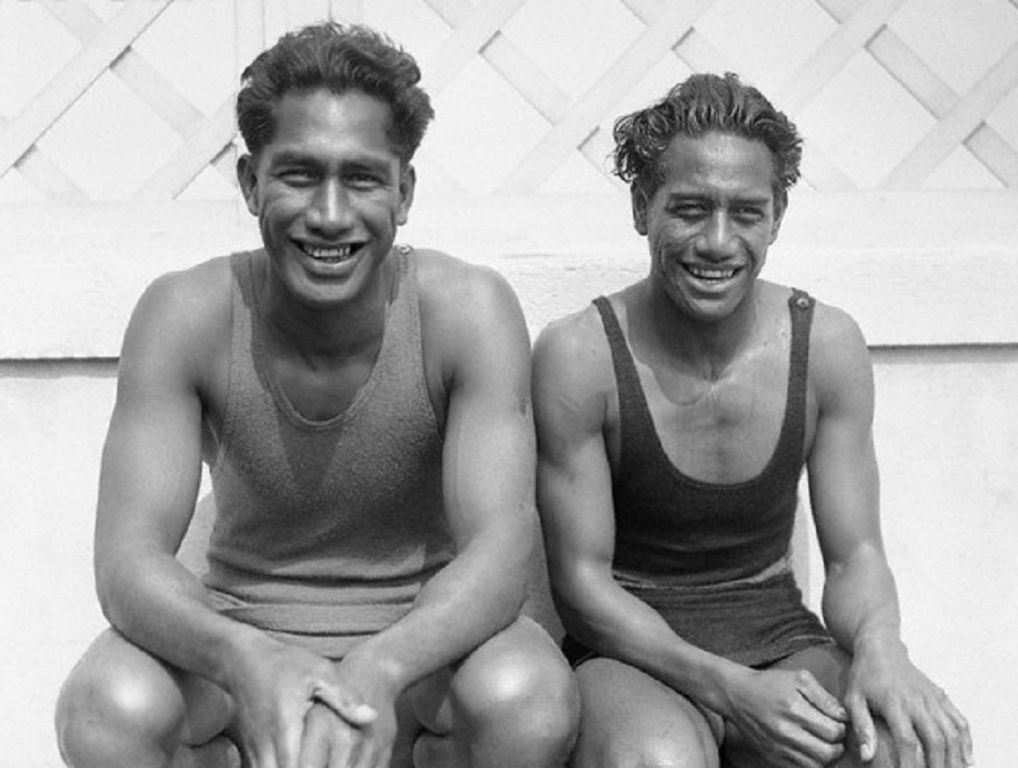
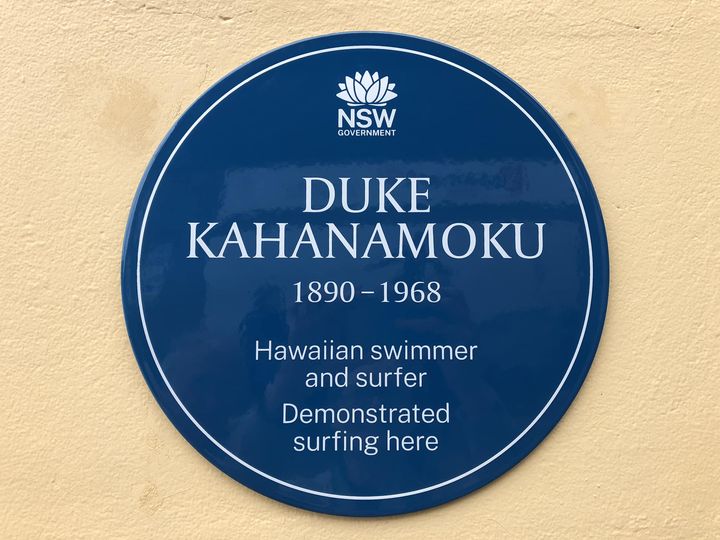






 IN a letter to Harry M. Hay, Australia’s foremost swimming and, surf coach, Tommy Walker, one-time surfboard champion at Manly (N.S.W.), writes: 'I saw an article by you in 'The Referee' re surfboards, so enclose a photo of myself and surfboard taken in 1909 at Manly. This board I bought at Waikiki Beach, Hawaii, for two dollars, when I called there aboard the 'Poltolock.' I won my first surfboard shooting competition at Freshwater carnival back in 1911, and that wasn't yesterday. Regards.'
IN a letter to Harry M. Hay, Australia’s foremost swimming and, surf coach, Tommy Walker, one-time surfboard champion at Manly (N.S.W.), writes: 'I saw an article by you in 'The Referee' re surfboards, so enclose a photo of myself and surfboard taken in 1909 at Manly. This board I bought at Waikiki Beach, Hawaii, for two dollars, when I called there aboard the 'Poltolock.' I won my first surfboard shooting competition at Freshwater carnival back in 1911, and that wasn't yesterday. Regards.'